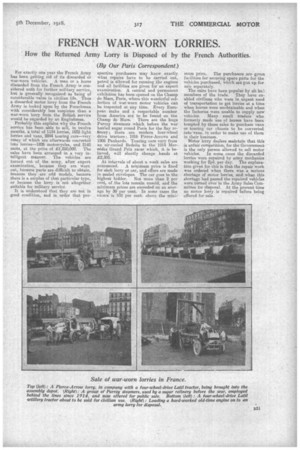FRENCH WAR-WORN LORRIES.
Page 9

If you've noticed an error in this article please click here to report it so we can fix it.
' How the Returned Army Lorry is Disposed of by the French Authorities.
(By Our Paris Correspondent.)
For exactly one year the French Army has been getting rid of its discarded or war-worn vehicles. A man or a horse discarded from the French Army is considered unfit for further military service, but is generally recognized as being of considerable value in civilian life. Thus a discarded motor lorry from the French Army is looked upon by the Frenchman with considerably less suspicion than a war-worn lorry from the British service would be regarded by an Englishman. Probably this explains why the French service has been able to sell, in twelve months, a total of 1134 lorries, 1655 light lorries and vans, 2844 touring ears—very many of which are afterwards converted into lorries-1826 motorcycles, and 2145 units, at the price of £.1,250,000. The sales have been arranged in a very intelligent manner. The vehicles are turned out of the army, after expert examination, because they are worn out, because parts are difficult to obtain, because they are odd models, because there is a surplus of that particular type, or because the lorry is not altogether suitable for military service. It is understood that they are not in good condition, and in order that pro spective purchasers may know exactly what repairs have to be carried out, petrol is allowed for running the engines and all facilities are given for an expert examination. A central and permanent exhibition has been opened on the Champ de Mars, Paris, where this wonderful collection of war-worn motor vehicles can be inspected at any time. Every European make and a respectable number from America are to be found on the Champ de Mars. There are the huge Purrey steamers which before the war hauled sugar round Paris for the Say refinery ; there are modern four-wheel drive tractors ; 1916 Pierce-Arrows and 1906 Panhards. Touring cars vary from an air-cooled Bedelia to the 1914 Mercedes Grand Prix racer which, it is believed, will shortly change hands at £2,500.
At intervals of about a week sales are announced. . A minimum price is fixed for each lorry or car, and offers are made in sealed envelopes. The car goes to the highest bidder. Not more than 2 per cent, of the lots remain unsold, and the minimum prices are exceeded on an average by 30 per cent. In some cases the excel's is 160 per cent. above the mini mum price. The purchasers aregiven facilities for securing epare parts for the vehicles purchased, which a.re put up for sale separately.
The sales have been popular by alt bu:1 members of the trade. They have enabled civilians who were in urgent need of transportation to get lorries at a time when horses were unobtainable and when the 'factories were unable to supply new vehicles. Many small traders who formerly made use of horses have been tempted by these sales to purchase vans or touring car chassis to be converted into vans, in order to make use of them in their business.
Motor lorry dealers maintain that this is unfair competition, for the Government) is the only person allowed to Bell motor vehicles. In some ewes the discarded lorries were repaired by army mechanics working for 2i-d. per day. The explanation given for this is that the repair work was ordered when there was a serious shortage of motor lorries, and when this shortage had passed the repaired vehicles were turned over to the Army Sales Committee for disposal. At the present time no motor lorry is repaired before being
offered for sale.. •






















